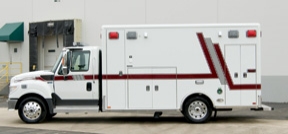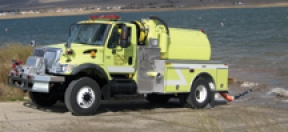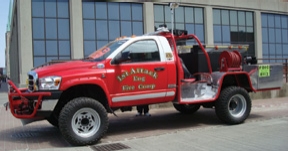 |
| Seattle Fire Department Engine 27, a 2003 American LaFrance Metropolitan with a 1,500-gpm Hale pump and a 500-gallon booster tank, supplies multiple lines at a four-alarm warehouse fire on Sept. 20. Engine 27 is one of nine ALF 2003 Metropolitans in front-line service in the city. The warehouse was scheduled for demolition, and the cause of the fire was accidental. One firefighter suffered a fractured ankle. (Fire Apparatus Photo By John Odegard) |
New fire truck orders are down significantly, and with the continuing strain on municipal budgets, apparatus manufacturers do not expect the situation to improve next year.
One manufacturer observed that the apparatus purchasing process is becoming more complicated, taking longer and, at times, turning political.
Another said many fire departments are adjusting to tight budgets by replacing two trucks with one apparatus capable of doing both jobs. In addition, most of the trucks that are being purchased do not have the kind of non-essential embellishments that have traditionally been so popular.
Manufacturers are finding that fire departments with enough money to buy new apparatus are seeking vehicles that can be used for more than one function – rescue-pumpers, pumper-tankers, quints and EMS-pumpers.
Mike Moore, director of strategic product development and support for Pierce Manufacturing Inc., said departments are purchasing the apparatus they need, not what they would like to have.
“The past days of frills and parade-style trucks have gone away, but those departments that still need a custom piece of apparatus will buy one, if they can find the funds,” Moore said. “We’re not seeing any trends in departments buying cheaper trucks; rather they’re buying exactly what they need for their municipalities.”
Philip Gerace, director of sales and marketing for KME Fire Apparatus, has seen changes in the purchasing process, especially among municipalities.
“It has become much more drawn out, complicated and political,” he said. “And the time frame from specifications to actual purchase is about 90 days longer than it traditionally has been. Budget issues have caused that because there are more sign-offs, more people involved in the process and chiefs are now charged with the political implications of spending money on fire trucks.”
Departments that are spending money on new fire trucks are choosing multi-function vehicles, he said. “We’re seeing departments buying rescue pumpers and rear-mounted units with rescue applications,” he said. “And our pumper-tanker business continues to be strong.”
Moore agreed that tight budgets are forcing fire departments to rethink their vehicle strategies. Many that do not have money for new equipment, he said, are trying to extend the useful lives of their fleets. “Others that can find the funds are moving toward combination vehicles like pumper-tankers and rescue pumpers,” he said. “We’re seeing a lot of departments replace two vehicles with one new vehicle that does both jobs.”
George Logan, vice president of commercial operations for E-ONE, said his company has also experienced a strong trend toward multi-functional vehicles.
“Rescue pumpers, quints, pumper-tankers, we’re seeing all those and other applications,” he said. “People are trying to do more functions with one piece of equipment instead of multiple pieces of apparatus.”
Logan said E-ONE and other manufacturers are adapting to the changing roles in the fire service.
“Firefighters are not there only to fight fires anymore,” he said. “So we’re seeing vehicles that accommodate medical equipment and first-responder type of equipment. These trends have manifested themselves more in 2010 because so many departments are strapped with budget constraints, and all the indicators from the market are that 2011 will be the same.”
Bill Doebler, vice president of sales and marketing for Crimson Fire, said most departments have adopted a mentality of “doing more with less.”
“Declining manpower, reduced budgets, and changes in buying cycles and apparatus purchases mean that people are trying to get as much bang for their buck as possible,” he said. “In the past they might have bought pumpers, aerials and rescues, but now they are looking more at cross-functional apparatus.”
In addition, he said many departments are bringing ambulances in house. “They are warming up to EMS,” he said, “because they are allowed to do third-party billing for EMS, but they can’t charge for fire calls.”
In response, Doebler noted that Crimson Fire launched a patient transport pumper – the First Response All Calls (FRAC) unit – built on either a custom or commercial chassis that can still meet a Class A pumper designation or that of a quick-attack piece.
“It is a traditionally designed pumper with patient transport in the rear,” he said. “It usually isn’t the first piece out the door on a structure fire, but it could be the second.”
Doebler pointed out that the pump on a fire truck is engaged on only an average of five percent of calls these days, which led Crimson to develop its Transformer series.
“The vehicle has a PTO-driven pump mounted in the wheel-well area, which shortens the wheelbase for better maneuverability,” he said. “And it provides enhanced storage capacity with the forward compartments being transverse all the way through where the pump traditionally would be located.”
Greater Responsibilities
Pierce Manufacturing developed the PUC (Pierce Ultimate Configuration) several years ago and offers it in pumper, tanker and combination packages.
“We repackaged the pump so it takes up less space on the truck,” Moore explained. “That increases compartmentation by 30 percent, yet still keeps a large cab and decreases the wheelbase by a foot-and-a-half. It’s being used not only as a pumper, but also in the rescue mode, and the vehicle allows for pump-and-roll capabilities.”
He pointed out that fire departments are taking on greater responsibilities. “They have to carry more and a wider variety of equipment, so they need more compartment space on their trucks,” he said. “Traditionally, a truck would have to get bigger, or you’d have to have two trucks; only recently have there been solutions, like the PUC, that facilitate carrying that extra equipment.”
Other manufacturers have also been making room on various types of apparatus for additional equipment.
EMS Personnel
George Logan of E-ONE said typical engine or ladder companies are now including EMS personnel on their rigs. “Depending on the level of care and service provided, you can even find telemetry equipment and drug boxes on some fire apparatus,” he said. “That’s where we have to provide a secure area for that equipment and in some cases climate control for particular drugs.”
In most cases that equipment is stored inside the cab, he said, but usually with access from both inside and outside the truck because “the fire department wants that equipment near at hand when the guys get off the rig.”
Manufacturers don’t like to talk about how far the market for fire apparatus has fallen due to the recession and its effects on municipal budgets. Some said fire truck orders industry-wide are down as much as 40 percent. Crimson’s Doebler estimated a 25 percent drop in apparatus purchasing over the past year.
“Typically, about 5,500 units are sold across the nation, but we are looking at around 4,000 or less that will be purchased in 2010,” he said. “And it doesn’t look like 2011 will be much better.”
|
|
||||
|
|
||||
|
|
||||
|
|
||||
|
|
||||
|
|
||||
|
|
More Fire Apparatus Current Issue Articles
More Fire Apparatus Archives Issue Articles




